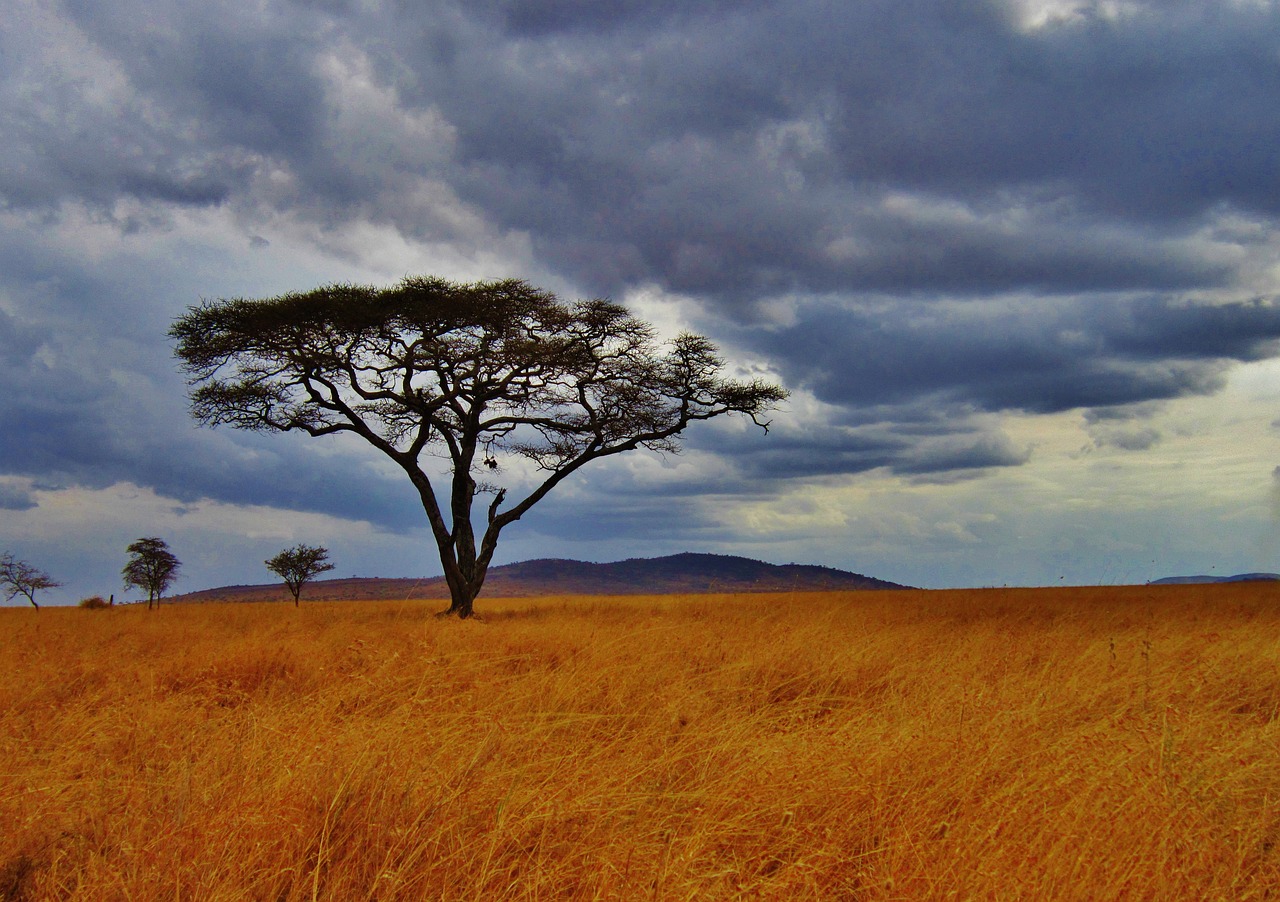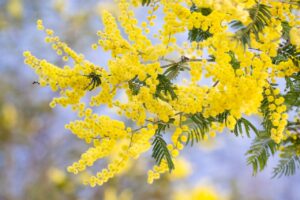Acacia
Overview
The Acacia genus, a member of the pea family, features trees and shrubs well-suited to warm climates. These hardy plants often boast vibrant foliage and cheerful yellow or white blossoms. Acacia species flourish in full sun and are drought-resistant, making them both practical and visually appealing additions to landscapes1 2 5.

Characteristics
Known for its rapid growth, drought tolerance, distinctive puffball flowers, and ability to thrive in warm climates.
Region
Commonly found in warm climates such as Australia, Africa, Hawaii, Mexico, and the southwestern United States.
Natural Habitat
Acacia plants are typically found in arid and semi-arid regions, including grasslands, open woodlands, and savannas.
Cultivation
Thrives in full sun, drought-tolerant, and prefers well-drained soil.
Uses and Benefits
Acacia trees offer both beauty and practicality in your garden or homestead. These resilient trees boast a charming weeping form and stunning puffball flowers in shades of yellow and white, which sweep across the landscape in spring4. Not only do they provide a visual feast, but they also serve as a valuable food source.
While the specific culinary applications of acacia are not detailed in the available research, their potential in the kitchen is certainly intriguing4. Acacia trees are also known for their hardiness, requiring minimal upkeep and thriving even in drought conditions5. This makes them an excellent choice for those looking to add a low-maintenance, yet beneficial plant to their environment.
Consider incorporating acacia trees into your landscaping for:
- Stunning visual appeal with weeping form and vibrant flowers
- Potential culinary uses as a food source
- Resilience against drought and minimal upkeep requirements
Embrace the beauty and benefits of acacia trees in your garden or homestead, and enjoy their easy, yet rewarding presence in your outdoor space.

Cultivation Tips
Growing Acacia trees is a delightful adventure for gardeners who appreciate low-maintenance plants. These resilient beauties adore basking in full sun and can handle drought conditions with ease, making them an ideal choice for warm, dry climates5. Acacia trees are known for their rapid growth, quickly reaching impressive heights of 20 to 40 feet4.
In the springtime, your garden will come alive with the enchanting display of Acacia‘s attractive, weeping branches adorned with charming puffball flowers. These blossoms burst forth in vibrant clusters of yellow or white, adding a delightful splash of color to your landscape4.
If you’re starting your Acacia journey with young trees, keep in mind that they may require some protection from curious wildlife1. However, once your trees are established, they will ask very little of you. Acacia trees are content to grow and thrive with minimal intervention, needing only the occasional check-in to ensure they are healthy and happy.
To ensure your Acacia trees flourish, consider the following tips:
- Plant your Acacia in a sunny location with well-draining soil
- Water deeply but infrequently, allowing the soil to dry out between watering sessions
- Prune your trees annually to maintain their shape and promote healthy growth
- Protect young trees from wildlife by using tree guards or fencing
With these simple care guidelines, your Acacia trees will reward you with their stunning beauty and low-maintenance nature for years to come.
Seasonal Considerations
When planning your Acacia garden, it’s important to consider the seasonal changes that affect these resilient plants. In the spring, Acacia trees burst into life with a spectacular display of fluffy, ball-shaped flowers clustered along their branches. These cheerful blooms, in shades of sunny yellow or crisp white, add a delightful pop of color to your landscape4.
As the seasons shift and summer arrives, Acacia trees prove their toughness by thriving in the heat and dryness of warm climates5. Their ability to handle drought conditions makes them a fantastic choice for gardens in areas with limited rainfall. However, it’s crucial to keep an eye on young Acacia trees during this time, as they may need protection from hungry wildlife looking for a tasty snack1.
When autumn rolls around, Acacia trees continue to showcase their adaptability. While some trees may shed their leaves in preparation for winter, many Acacia species keep their foliage year-round, providing a constant source of green in your garden. This evergreen nature adds visual interest and texture to your landscape, even as other plants begin to die back.
As winter sets in, Acacia trees demonstrate their hardiness by withstanding cooler temperatures. While they prefer warmer climates, many species can tolerate a bit of cold, making them a suitable option for gardens in milder winter regions. To ensure your Acacia trees remain healthy throughout the winter months, it’s a good idea to:
- Mulch around the base of the tree to insulate the roots
- Protect young trees from frost damage by covering them during cold snaps
- Prune away any dead or damaged branches to maintain the tree’s shape and health
By understanding the seasonal needs of Acacia trees, you can create a thriving, low-maintenance garden that showcases the beauty and resilience of these incredible plants year-round.

Issues and Troubleshooting
While Acacia plants are generally low-maintenance and resilient, there are a few issues to watch out for to ensure their continued health and vitality:
- Protecting young plants: Young Acacias may need extra protection from hungry animals who find their tender shoots irresistible. Consider using physical barriers or repellents to deter browsing until the plants are established.1
- Thorny hazards: Some Acacia species have sharp thorns that can pose a risk to people and animals. Be mindful of the plant’s location and consider pruning if necessary to prevent accidents or injuries.5
- Pest and disease monitoring: Although generally resistant, Acacias can occasionally fall prey to pests like scale insects or diseases such as root rot. Regularly inspect your plants for signs of distress and take appropriate action if needed.
- Pruning and maintenance: Occasional pruning can help maintain the shape and size of your Acacia, as well as remove any dead, damaged, or diseased branches. This promotes healthy growth and prevents potential issues down the line.
By staying vigilant and addressing these concerns proactively, you can ensure your Acacia plants remain healthy, beautiful, and trouble-free for years to come. With their hardy nature and minimal upkeep requirements, Acacias make a fantastic addition to any landscape suited to their growing conditions.
History and Folklore
The Acacia tree has been a symbol of resilience, purity, and endurance for centuries, with its roots firmly planted in the history and folklore of various cultures. This hardy tree has stood the test of time, weaving its way through ancient civilizations and leaving an indelible mark on religious rituals and ceremonies.
In Egyptian mythology, the Acacia tree was believed to have a strong connection to the god Osiris, symbolizing the cycle of life, death, and rebirth. The ancient Egyptians revered the tree for its ability to thrive in harsh desert conditions, seeing it as a representation of the indomitable spirit of their deity.
The Acacia also holds a significant place in Judeo-Christian tradition, as it is mentioned in the Bible as the wood used to construct the sacred Ark of the Covenant. This biblical reference further solidifies the tree’s importance and its association with divine protection and endurance.
Beyond its religious significance, the Acacia tree has been a frequent subject in folklore and legends across cultures. Its sturdy branches and lush foliage have served as powerful symbols, often representing the resilience of the human spirit in the face of adversity. Many tales depict the tree as a steadfast companion, providing shelter, wisdom, and strength to those who seek its comfort.
As a testament to its longevity and adaptability, the Acacia tree continues to thrive in various regions around the world, from the savannas of Africa to the arid landscapes of Australia. Its presence serves as a reminder of the enduring power of nature and the interconnectedness of human history and the natural world.
References
1. Acacia Tree Care: Information About Acacia Tree Types – Gardening Know How, https://gardeningknowhow.com
2. Acacia Trees: Types, Leaves, Flowers, Thorns – Leafy Place, https://leafyplace.com/acacia-trees/
3. Acacia Tree: Description, Types, and Care Tips (Full Guide), https://www.planetnatural.com/acacia-tree/
4. How to Grow Acacia Tree – Gardening Channel, https://www.gardeningchannel.com/how-to-grow-acacia-tree/
5. Acacia – Gardenista – Sourcebook for Cultivated Living, https://www.gardenista.com/garden-design-101/shrubs/acacia-shrubs-plant-care-growing-guide/
Image Credit: Michelle_Raponi
Image Credit: Hans
Image Credit: pen_ash
Nicolas Duval
Nicolas is a passionate advocate for nature and the art of wildcrafting. His dedication shines through in Wildcraftia, a website he meticulously crafted to serve as a haven for nature enthusiasts worldwide. Driven by a deep appreciation for nature’s connection to humanity, Nicolas embarked on his journey in 2011 with SmokableHerbs, a platform showcasing his love for nature’s bounty. Building upon this foundation, he established Smokably, a thriving online store offering premium herbs and blends to a global audience.
